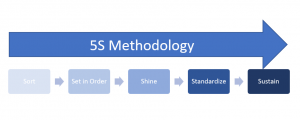Is Your Crisis Management Plan Lean?
Leanne Metz, PMP, MBCI and Brent Wahba
Lean is a systematic method for “delivering the most customer value while consuming the fewest resources.” I’m an advocate of using Lean in business processes in order to simplify and standardize them. Lean identifies “value added” activities in order to reduce “non value added” activities. “Value added” is defined as “any activity or process that a customer is willing to pay for”. There are activities that must be performed that can’t be tied to “customer willingness to pay”. Examples of these are payroll, legal, compliance, and crisis management planning. The “customers” of your crisis management program are your employees, stockholders, and community.
There are many ways to apply Lean to business, and one tool within the Lean methodology is 5S. How can you apply 5S to your crisis management plan? Let’s start with an overview of 5S:
* Sort: Keep only necessary items
Review your crisis management plan, tools, templates. Have you included only the items you may need when a crisis occurs? Components you may be able to move out of the response plan include roles and responsibilities, training, exercise requirements, preparedeness activities, etc. These should be available, but not in the response plan which makes it bigger and more difficult to find the critical items needed for a response.
* Set in Order: Arrange items to promote efficient workflow
Organize your plan in the sequence in which it will likely occur. It could be as simple as Before (Training, Roles & Responsibilities, Exercise Requirements) During (Assemble the Team, Initial Briefing Cycle, . . .) After (Recovery, Lessons to be Learned).
* Shine: Clean the work area so it is neat and tidy
Is it easy to find the information in the plan? The crisis team should be able to quickly find the relevant information. If you have a standard process that’s color coded, you can code the plan to reflect the correct stage or crisis level.
* Standardize: Set standards for a consistently organized workplace
Identify how the tools, templates etc. will be managed going forward. How will changes be communicated? Where will information be stored? (Crisis Management Plan, Incident Action Plan, etc) Ensure clear roles, responsibilities and incident action plans are in place.
* Sustain: Make it a habit
Train Crisis Teams and Crisis Coordinators. Identify who will monitor to ensure the resources stay organized. What’s the process to operationalize identified Lessons “to be” Learned within the resources, in order to incorporate ongoing continuous improvement. (Lessons “to be” learned are considered “learned” when they have been institutionalized into the process, tools, training, etc. )
After “5S” your crisis plan should be well organized, information is easy to find, and your “customers” are willing to pay for the value add from the plan.



Some plans are less than lean. One problem is they’re often developed by someone that is not going to have to implement it during a crisis. Training and exercises to clearly understand the plans, processes and procedures is always essential and can’t be skipped. Great post!